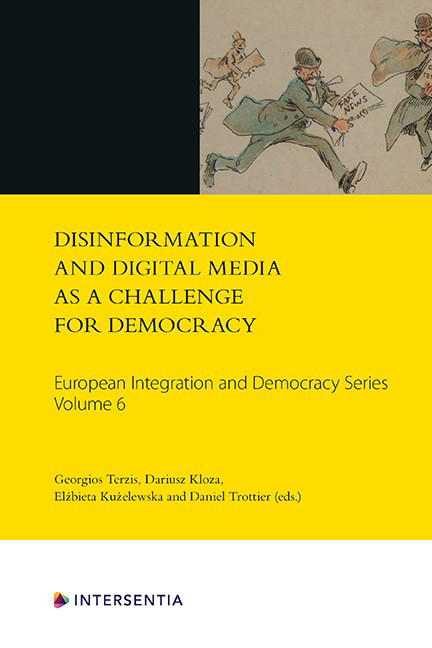Book contents
- Frontmatter
- Foreword: Fooling All of the People All of the Time: Democracy in the Age of Fake News
- Introduction: ‘They All Hear “Ping” at the Same Time’
- Contents
- List of Abbreviations
- List of Contributors
- PART I THEORETICAL APPROACHES TO AND THE CONCEPTUALISATION OF DISINFORMATION
- PART II EXPERIENCE OF DEALING WITH DISINFORMATION
- PART III SOLUTIONS TO DEAL WITH DISINFORMATION AND THEIR CRITIQUE
14 - Fake News and Freedom of Expression and Information: The Legal Framework and Policy Actions at the EU Level to Address Online Disinformation
Published online by Cambridge University Press: 26 May 2021
- Frontmatter
- Foreword: Fooling All of the People All of the Time: Democracy in the Age of Fake News
- Introduction: ‘They All Hear “Ping” at the Same Time’
- Contents
- List of Abbreviations
- List of Contributors
- PART I THEORETICAL APPROACHES TO AND THE CONCEPTUALISATION OF DISINFORMATION
- PART II EXPERIENCE OF DEALING WITH DISINFORMATION
- PART III SOLUTIONS TO DEAL WITH DISINFORMATION AND THEIR CRITIQUE
Summary
INTRODUCTION
Recent events have sparked a heated debate about the influence of fake news. Some suggest that fake news led to a spate of surprise election results, including the rejection of the Colombian peace agreement by referendum, the Leave campaign's victory in the Brexit referendum and, very significantly, Donald Trump's win in the US presidential elections.
Fake news, of course, is not a new phenomenon. Publishing unverified stories – in lay terms, bad journalism – is the equivalent of what was always referred to as propaganda or yellow journalism. With the explosion of information and communication technologies, however, fake news has taken on a new dimension. While online media, such as blogs, social networks and websites, are excellent at helping people to communicate and provide access to huge amounts of information, they also allow fake news to reach anyone. This situation has changed the functional nature of the right to information, which was always tied directly to the right to freedom of opinion. The key difference, therefore, between fake news published in traditional media and fake news published online is that the latter have a greater impact and go viral because they are shared around the world on social media.
Fake news might seem like a new phenomenon, but the only thing that is new is the platforms used to share it – the sites on which all the stories are fabricated. The sites are designed to look reliable and use sensationalist titles to attract readers. The controversies that these malicious news stories create are mainly the fault of the authors and sites that create them, but the social media platforms that help them go viral and the advertising platforms that fund them are also to blame.
Traditional media have also been guilty of disseminating false or unverified news, albeit far less often. When traditional media publish fake news, it is usually connected to the current structural crisis of journalism as a sustainable model. Over the last decade or so, there has been a seismic shiftin the business model of the press, which has been unable to generate a profit through its traditional advertising model.
- Type
- Chapter
- Information
- Disinformation and Digital Media as a Challenge for Democracy , pp. 269 - 290Publisher: IntersentiaPrint publication year: 2020
- 1
- Cited by



